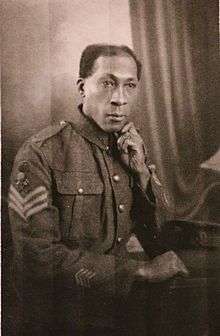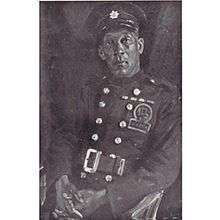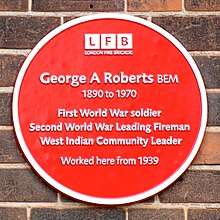George Arthur Roberts
George Arthur Roberts BEM MSM (1 August 1890 – 8 January 1970) was a Trinidadian soldier, firefighter, and community leader in Great Britain.
George Arthur Roberts | |
|---|---|
 | |
| Born | 1 August 1891 Trinidad & Tobago |
| Died | 8 January 1970 (aged 79) London, England |
| Occupation | First World War soldier, Second World War fireman, West Indian Community Leader |
He served in the First World War, where he became known as the "Coconut bomber" and went on to become a firefighter during the Blitz and rest of the Second World War. In 1944 he was awarded the British Empire Medal "for general duties at New Cross Fire Station" and for his part as a founder and pioneer of the discussion and education groups of the fire service. A blue plaque has been erected in his honour in Camberwell, London Borough of Southwark.
First World War
When the war began, Roberts enlisted in the Trinidad Army and then signed up to the European Service and worked his way from Trinidad to England, where he was placed in the Middlesex Regiment. As a rifleman attached to the Middlesex Regiment, he fought in the battles of Loos, the Somme and in the Dardanelles. He was wounded first at the Battle of Loos, and then in the Battle of the Somme.
According to the wartime magazine, Every Week , he distinguished himself by his "extraordinary" ability to throw bombs back into enemy lines, as he did with coconuts as a child, and became known as the "Coconut Bomber".[1]
The magazine also reported that he was given special leave to return to Trinidad to recruit more volunteers and was able to sign up more than 250 men with his "vigorous speeches".[1]
Standing at 6’2", Roberts earned a reputation in the Great War for throwing bombs back over enemy lines.[2]
After the war he settled in London firstly living in Peckham and then Camberwell where Roberts and his family lived for almost 50 years.
League of Coloured Peoples
Roberts earned a living as an electrician, a trade he’d learnt in Trinidad, but found himself up against the bigotry that he and the other black people were subjected to in their day-to-day lives, war heroes or not.
In response, in 1931, he joined as one of the founder members of the League of Coloured Peoples, the era’s most influential civil rights organisation and one of the first organisations to take care of the needs of Britain’s black community, and according to its 1944 minutes was a member of its executive committee "almost from the inception".
World War II fireman
When the Second World War broke out, he was too old for combat. Instead he enlisted for the Home Front, saving countless lives in Southwark as a firefighter during the Blitz, having completed his training with the fire service in 1939.
In 1943, Roberts was made a section leader[3] and in the King's 1944 Birthday Honours he was awarded the British Empire Medal[4] "for general duties at New Cross Fire Station" and for his part as a founder and pioneer of the Discussion and Education groups of the fire service throughout the Second World War.
Thousands of men and women would turn up to such groups at their local station houses every week in this government-inspired effort at consciousness-raising.
'If what I am doing can assist in some small way to bring about a better understanding and a true fellowship amongst the peoples of the earth, I shall be extremely happy' Roberts told the BBC programme 'Calling the West Indies' on 4 May 1947.[5][6]
Roberts was also awarded the Meritorious Service Medal (United Kingdom).
British Legion

Roberts was passionate about the plight of his fellow ex-servicemen and campaigned over the years on behalf of The National Federation of Discharged and Demobilised Sailors and Soldiers, going on to found the local branch of the British Legion. He led thousands of ex-servicemen, including those with battle-wounded who were unable to walk, in a march demanding improved rights and higher pensions.
Roberts was so well known at the time that he was even painted by the portrait artist, Norman Hepple.
After his death in 1970, he became a forgotten figure until interest in the pre-Windrush generation of black migrants began to surface about a decade ago and he is featured in Stephen Bourne’s book Black Poppies - Britain's Black Community & the Great War , the story of men of the "old British Empire" who regarded joining the war effort as a matter of honour. [7]
Marriage and children
In Trinidad, Roberts had two daughters, Violet and Stella, with Delcina Green. After the First World War, George settled at 84 Meeting House Lane in Peckham. On 6 October 1920 he married Margaret Whyland in Camberwell and they moved to 40 Bournemouth Road before settling in the Lewis Trust Dwellings in Warner Road, Camberwell which remained his home until he died in January 1970 at King's College Hospital, London. A fortnight later, on 20 January, Roberts was cremated at Honor Oak Crematorium and his ashes scattered on the New Circular Lawn.[8]
Margaret and George had two sons, Cyril and George Victor.
Margaret died in 1937 and Roberts then married Rose Barnett in 1941.
Blue Plaque

In September 2016, Roberts was honoured with a blue plaque by the London Borough of Southwark for the first black man to serve in the army and fire brigade.[9][10] [11]
The text of the plaque is "George A. Roberts 1890 to 1970 First World War soldier, Second World War fireman, West Indian Community Leader. Lived here 1923 to 1970. Voted by the people".[12]
The plaque is located on the Lewis Trust Dwellings in Warner Road, Camberwell, London. The scheme was led by the Southwark Heritage Association.[13]
At the unveiling firefighters solemnly formed a guard of honour at the ceremony.[14] The ceremony was attended by family, politicians including Harriet Harman and the Mayor of Southwark, and assorted dignitaries, including the Acting High Commissioner of Trinidad and Tobago.
Southwark historian Stephen Bourne had featured George in his book Black Poppies - Britain's Black Community and the Great War (The History Press, 2015) and he continued to research his life and career. Stephen then nominated George for the blue plaque. When his nomination was accepted, Stephen led a campaign for George to win. George not only won, but proved to be a popular choice with voters
Red Plaque

On Sunday 15 April 2018 a red plaque was unveiled by London Fire Brigade on New Cross Fire Station in South East London where he was stationed in World War Two.
The text of the plaque reads:
George A Roberts BEM
1890 to 1970
First World War Soldier
Second World War Leading Fireman
West Indian Community Leader
Worked here from 1939
References
- Every Week Magazine (1918)
- "One of the first black men to serve in the british army and in London fire brigade honoured in ceremony". www.itv.com.
- "War time fire fighter gets blue plaque". www.london-fire.gov.uk.
- London Gazette, 2 June 1944, page 2680
- BBC programme 'Calling the West Indies'
- Stephen Bourne, 'Vigorous speeches inspired new recruits', South London Press, 9 September 2016
- "www.camdenreview.com".
- "deceasedonlineblog.blogspot.co.uk: George Arthur Roberts".
- "Southwarknews: Blue Plaque First Black Man Serve Army Fire Brigade".
- "www.harrietharman.org: Honouring_the_life_of_radical_hero_civil_rights_activist".
- "www.voice-online.co.uk: Trinidadian-WWI-Veteran-wins-Southwark-blue-plaque-honour".
- "openplaques.org: Blue Plaque".
- "Southwark Heritage Association: Blue plaques".
- "www.london-fire.gov.uk:Groundbreaking wartime firefighting hero recognised with blue plaque".